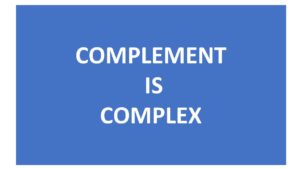One of the simplest and clearest overview images to illustrate the Complement system is provided by an organisation called Euro Diagnostica . It can be seen at the bottom of the page found by clicking here.
Over time aHUS patients get to hear, and become familiar with the three pathways of the Complement System ( Alternative, Lectin, Classic ) as well as terms such as C5 or CFH or CD46 ,which are just medical shorthand for the component parts of the Complement system. There are about 30 components in total in the Complement system, which are there to cleave, or chop, other parts; into big pieces, renamed by adding a “b” as in C3b, and small pieces renamed with an “a” such as C5a, or, to stick to, or coat other components to either to make them work or stop them working .
C3 is at the heart of it all, as can be seen in the overview, and even when its bigger piece C3b joins with big bits of CFB (Bb) in a “tick over” state it is good for the body (particularly in the brain); but when something happens to accelerate its activity (called amplification) that is good too if deals with the things it is there to deal with, things foreign to the body,(called pathogens in Doctors speak).
However in the case of aHUS patients it gets too active, because the parts of their complement system such as CFI and CFH ,which are there to control the joined up C3bBb by chopping it or sticking to it to make it inactive, cannot because they are defective and cannot do the job they are supposed to do.
As a result the next steps in the pathway become over active when they are not really needed and start to attack the body’s cells in a form of “friendly fire”. It is that which causes the patient to become ill, when, strictly speaking, there may be nothing there to make them really ill at all.

The Complement system is difficult to understand, and the possible combinations of individual components to be defective are enormous; and each combination of defective parts will results in different illnesses. Some of these defects are rare, but there also common variants too that affect the impact of the rare variants.
It is becoming increasingly accepted that Complement is implicated in many illnesses with an immune element, such as Paroxysmal Nocturnal Haemoglobinuria (PNH) , lupus, antiphospholipid syndrome ( Hughes Syndrome) , asthma, age-related macular degeneration, arthritis, multiple sclerosis, inflammatory bowel diseases, Alzheimers, IAGN , MPGN/DDD , organ rejection, ischemia reperfusion injuries and more TMAs ; including aHUS of course.
Eculizumab is a monoclonal antibody targeting the component C5. Eculizumab was developed in research to sort out the problems with C5 in the disease called Paroxysmal Nocturnal Haemoglobinuria ,or PNH.
PNH patients have a non malignant condition in their bone marrow which creates excessive defective red blood cells , which although work as they should the defective cell surface attracts attention from the Complement System to remove them, leaving only insufficient non defective red blood cells .
Although aHUS patients disease is directly associated with defects in several components of the Complement system ,eculizumab still works for them .This was found out in translational research, which illustrates why greater understanding of Complement System can lead to therapies for other instances when Complement is over and under Complementing.

